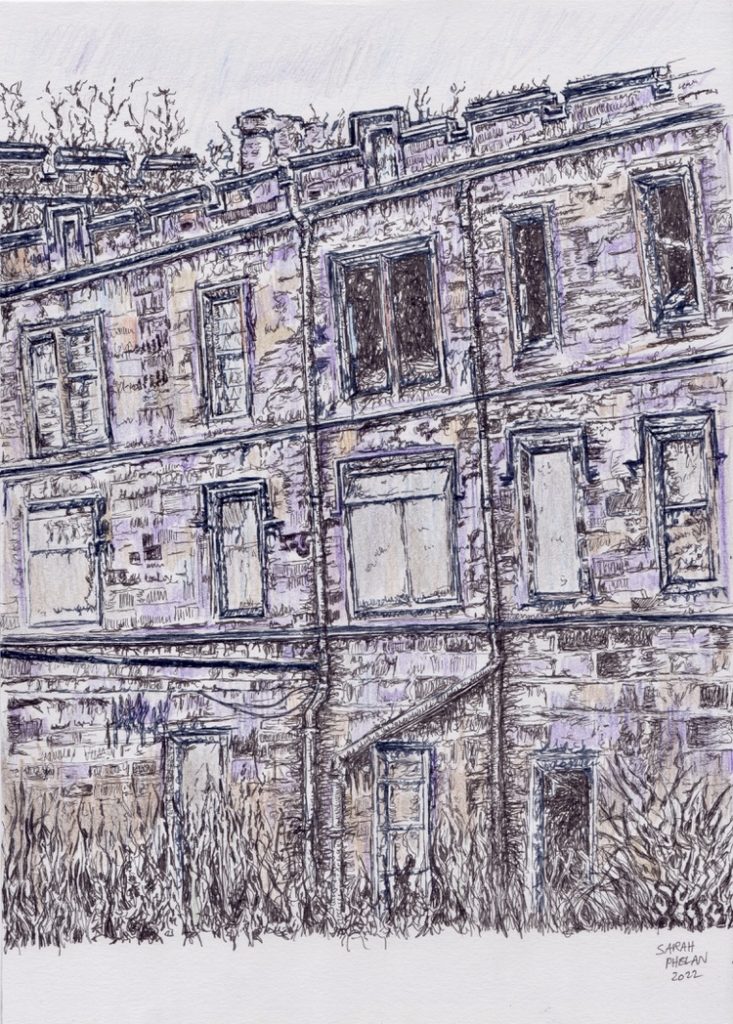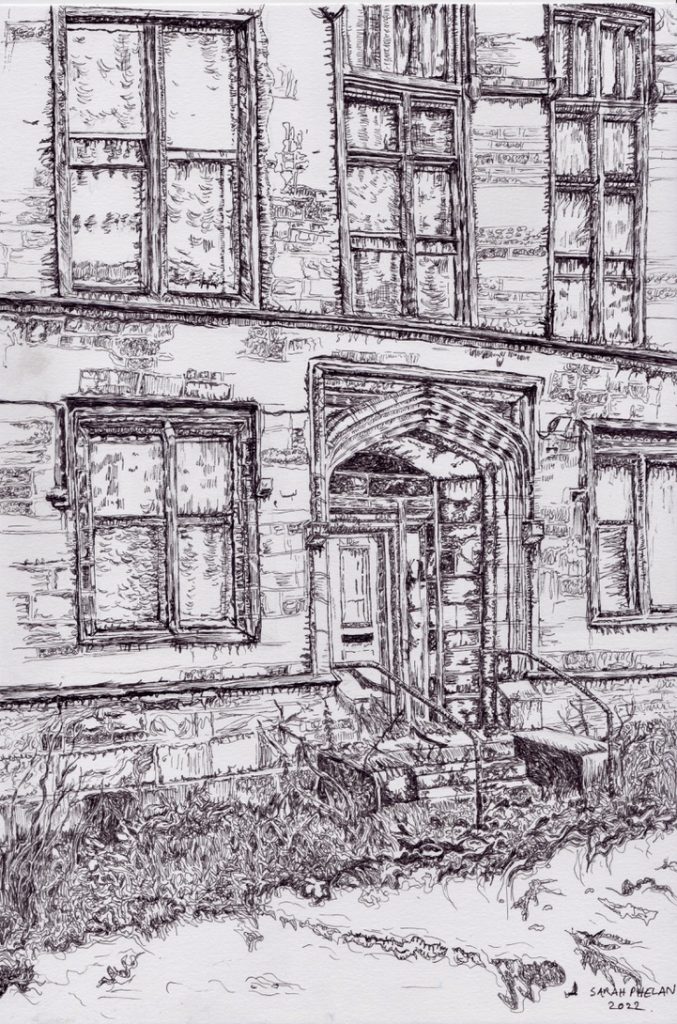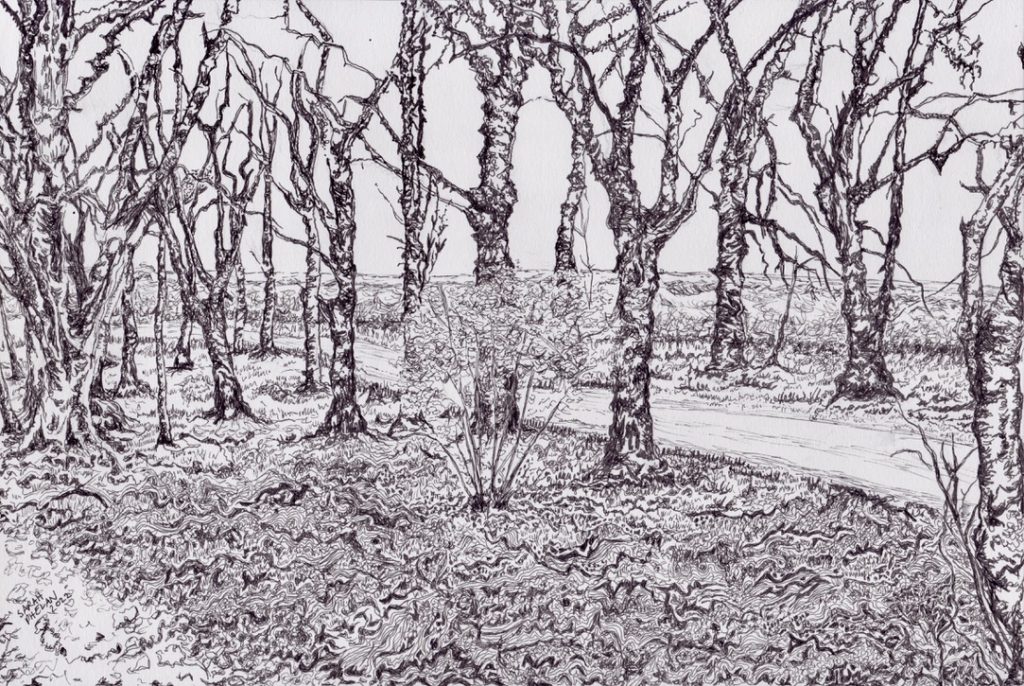Four Gartnavel drawings
Sarah Phelan

Trees of Gartnavel

Broken Buildings

Old Portals

Asylum Tree Walk
Commentary
This series of drawings are an artistic exploration of Gartnavel (Glasgow Royal Mental Hospital) as it stood on one January evening in 2017. The four works depict Gartnavel’s distinctive buildings and grounds, textured by my academic interest in the history of this institution and by a creative, imaginative connection with the emotional and psychological life which inhered within it.
My background is in interdisciplinary academic research; for my PhD in Medical Humanities at the University of Glasgow, I researched the personal papers of the Scottish psychiatrist, Thomas Ferguson Rodger (1907-1978) held at the University of Glasgow Archive Services. This research has at times skimmed and intersected with the history of Gartnavel. As Professor of Psychological Medicine at the University of Glasgow (1948-1973), Rodger’s department was based at the Southern General Hospital. However, from 1933-1940, he was deputy superintendent of Gartnavel, having also worked there after his medical studies (1). The Writing the Asylum project offered me the opportunity to turn towards Gartnavel and its archive in a resolutely creative, intuitive spirit. In preparation, I perused its substantial collection of photographs, allowing myself to dwell in particular on the faces of the patients who once lived there (2).
These four drawings represent the areas of Gartnavel surrounding West House and East House. Trees of Gartnavel shows West House viewed from the grounds below and glimpsed through a stark parade of wintery trees. Broken Buildings depicts East House in a state of decay, its windows yawning open or boarded up, while Old Portals shows its arched doorway, attended by weeds. Asylum Tree Walk captures Gartnavel’s elegant and eerie tree-lined path.
The drawings are based on a series of greyscale photographs I took using a camera phone on a bleak January day in 2017. I happened to be in the environs of Gartnavel and wandered around a little, spurred by my historical interest in Glasgow’s mental health provision. I took a couple of substandard photographs purely for myself. I remember trying to really look at and into these old buildings, to attune myself to the atmosphere of the place, to pick up the feelings and lives which might have accrued there over the years. When invited to participate on the ‘Writing the Asylum’ project, I was based in Ireland. Though I longed to revisit Glasgow and Gartnavel to take new photographs with higher resolution and from more appealing angles, this was not possible due to the pandemic. I instead returned to contemplate my 2017 photos, to study the characters of the buildings and the landscape, to grasp at their more ephemeral emotional and psychological history.
Before the advent of this project in 2020, I had completed Trees of Gartnavel, a mixed media composition using pen and ink, and colouring pencil, which was based on one of the more striking photographs in terms of layout. Following the formal inception of the project, I completed another mixed media piece Broken Buildings, again in pen and ink, and colouring pencil. For these works, I used a palette of bruise-like hues of purples, blues and browns to imbue the buildings and the trees with a wounded, pensive quality. I then completed two monochromatic works in pen and ink: Asylum Tree Walk and Old Portals.
For each piece, I began with a delicate under-drawing in light pencil, blocking in the main components and layout of the picture. I then worked over this in pen adding detail, using a sketchy, scribbling style to capture feelings and impressions rather than an exact representation. Although pen can be employed to achieve precision, I use it here in a freer, more painterly manner allowing lines to trail off, texture to take on an expressive quality and marks to veer from feathery to forceful. For example, a loose control of the pen gave the brickwork an unsteady, crumbling appearance. For me, this gave the buildings an almost sentient character; they stand almost reluctantly as weary witnesses to psychiatry’s past. I allowed the wind-blown grass in the various works to assume the surface of a wild and stormy sea as different pen marks collided discordantly: heavy and spiky waves, lacy ripples, erratic scribbles and swirls. This was suggestive of a submerged psychological and emotional tumult which the site was asking me to acknowledge.
I am not sure if I have achieved what I intended, or if I have realised something more, something different through this artwork. As I have followed the textures and lines of Gartnavel’s physical environment, its old buildings, brickwork and barbed treescape, I have sought to gesture towards the immaterial, the worlds of feeling it once held. Yet perhaps these drawings are more effectively self-revelatory. They are an artefact of how this site speaks to me; they expose how I experience its history, its very particular sense of place.
References
(1) Letter of application, 26 April 1937, Dr Thomas Ferguson Rodger (c.1933-1963), Staff Records of the Physician Superintendent, Records of Gartnavel Royal Hospital, Glasgow, Scotland, NHS Greater Glasgow and Clyde Archives, Mitchell Library, Glasgow, HB13/20/179, 1-2.
(2) Photographs, c 20th century, Records of Gartnavel Royal Hospital, Glasgow, Scotland, NHS Greater Glasgow and Clyde Archives, Mitchell Library, Glasgow, HB13/15.
[Gartnavel Royal Hospital: Conservation Audit (of 1843 buildings) compiled by Simpson & Brown Architects for commissioning clients NHS Greater Glasgow and Clyde (July 2009)]
Sarah Phelan is currently an independent researcher. She was previously an Affiliate Researcher of the School of Geographical and Earth Sciences at the University of Glasgow. She received a BA in English and Philosophy (2008) and an MA in English in Modernities (2009) from University College Cork, Ireland. She completed an interdisciplinary MSc in the History and Theory of Psychology at the University of Edinburgh in 2012. From 2013 to 2018, she undertook a PhD in Medical Humanities at the Medical Humanities Research Centre at the University of Glasgow, funded by a Lord Kelvin Adam Smith PhD scholarship. Her doctoral project explored the contribution to psychiatry of Thomas Ferguson Rodger (1907-1978), first Professor of Psychological Medicine (1948-1973) at the University of Glasgow and a consultant psychiatrist at a number of Glasgow hospitals.
Sarah has published peer-reviewed articles in History of Psychiatry, History of the Human Sciences and Cultural Geographies and book reviews in the Journal of Historical Geography and History of Psychiatry. Her research interests encompass medical humanities, the history and theory of the psy disciplines, and the history of dreaming. She is a member of the Asylum and Post-Asylum Spaces Group at the University of Glasgow, the Northern Network for Medical Humanities Research, the Arts Health Early Career Research Network and the Network of Cultural Dream Studies.
Four Gartnavel drawings
Sarah Phelan

Trees of Gartnavel

Broken Buildings

Old Portals

Asylum Tree Walk
Commentary
This series of drawings are an artistic exploration of Gartnavel (Glasgow Royal Mental Hospital) as it stood on one January evening in 2017. The four works depict Gartnavel’s distinctive buildings and grounds, textured by my academic interest in the history of this institution and by a creative, imaginative connection with the emotional and psychological life which inhered within it.
My background is in interdisciplinary academic research; for my PhD in Medical Humanities at the University of Glasgow, I researched the personal papers of the Scottish psychiatrist, Thomas Ferguson Rodger (1907-1978) held at the University of Glasgow Archive Services. This research has at times skimmed and intersected with the history of Gartnavel. As Professor of Psychological Medicine at the University of Glasgow (1948-1973), Rodger’s department was based at the Southern General Hospital. However, from 1933-1940, he was deputy superintendent of Gartnavel, having also worked there after his medical studies (1). The Writing the Asylum project offered me the opportunity to turn towards Gartnavel and its archive in a resolutely creative, intuitive spirit. In preparation, I perused its substantial collection of photographs, allowing myself to dwell in particular on the faces of the patients who once lived there (2).
These four drawings represent the areas of Gartnavel surrounding West House and East House. Trees of Gartnavel shows West House viewed from the grounds below and glimpsed through a stark parade of wintery trees. Broken Buildings depicts East House in a state of decay, its windows yawning open or boarded up, while Old Portals shows its arched doorway, attended by weeds. Asylum Tree Walk captures Gartnavel’s elegant and eerie tree-lined path.
The drawings are based on a series of greyscale photographs I took using a camera phone on a bleak January day in 2017. I happened to be in the environs of Gartnavel and wandered around a little, spurred by my historical interest in Glasgow’s mental health provision. I took a couple of substandard photographs purely for myself. I remember trying to really look at and into these old buildings, to attune myself to the atmosphere of the place, to pick up the feelings and lives which might have accrued there over the years. When invited to participate on the ‘Writing the Asylum’ project, I was based in Ireland. Though I longed to revisit Glasgow and Gartnavel to take new photographs with higher resolution and from more appealing angles, this was not possible due to the pandemic. I instead returned to contemplate my 2017 photos, to study the characters of the buildings and the landscape, to grasp at their more ephemeral emotional and psychological history.
Before the advent of this project in 2020, I had completed Trees of Gartnavel, a mixed media composition using pen and ink, and colouring pencil, which was based on one of the more striking photographs in terms of layout. Following the formal inception of the project, I completed another mixed media piece Broken Buildings, again in pen and ink, and colouring pencil. For these works, I used a palette of bruise-like hues of purples, blues and browns to imbue the buildings and the trees with a wounded, pensive quality. I then completed two monochromatic works in pen and ink: Asylum Tree Walk and Old Portals.
For each piece, I began with a delicate under-drawing in light pencil, blocking in the main components and layout of the picture. I then worked over this in pen adding detail, using a sketchy, scribbling style to capture feelings and impressions rather than an exact representation. Although pen can be employed to achieve precision, I use it here in a freer, more painterly manner allowing lines to trail off, texture to take on an expressive quality and marks to veer from feathery to forceful. For example, a loose control of the pen gave the brickwork an unsteady, crumbling appearance. For me, this gave the buildings an almost sentient character; they stand almost reluctantly as weary witnesses to psychiatry’s past. I allowed the wind-blown grass in the various works to assume the surface of a wild and stormy sea as different pen marks collided discordantly: heavy and spiky waves, lacy ripples, erratic scribbles and swirls. This was suggestive of a submerged psychological and emotional tumult which the site was asking me to acknowledge.
I am not sure if I have achieved what I intended, or if I have realised something more, something different through this artwork. As I have followed the textures and lines of Gartnavel’s physical environment, its old buildings, brickwork and barbed treescape, I have sought to gesture towards the immaterial, the worlds of feeling it once held. Yet perhaps these drawings are more effectively self-revelatory. They are an artefact of how this site speaks to me; they expose how I experience its history, its very particular sense of place.
References
(1) Letter of application, 26 April 1937, Dr Thomas Ferguson Rodger (c.1933-1963), Staff Records of the Physician Superintendent, Records of Gartnavel Royal Hospital, Glasgow, Scotland, NHS Greater Glasgow and Clyde Archives, Mitchell Library, Glasgow, HB13/20/179, 1-2.
(2) Photographs, c 20th century, Records of Gartnavel Royal Hospital, Glasgow, Scotland, NHS Greater Glasgow and Clyde Archives, Mitchell Library, Glasgow, HB13/15.
[Gartnavel Royal Hospital: Conservation Audit (of 1843 buildings) compiled by Simpson & Brown Architects for commissioning clients NHS Greater Glasgow and Clyde (July 2009)]
Sarah Phelan is currently an independent researcher. She was previously an Affiliate Researcher of the School of Geographical and Earth Sciences at the University of Glasgow. She received a BA in English and Philosophy (2008) and an MA in English in Modernities (2009) from University College Cork, Ireland. She completed an interdisciplinary MSc in the History and Theory of Psychology at the University of Edinburgh in 2012. From 2013 to 2018, she undertook a PhD in Medical Humanities at the Medical Humanities Research Centre at the University of Glasgow, funded by a Lord Kelvin Adam Smith PhD scholarship. Her doctoral project explored the contribution to psychiatry of Thomas Ferguson Rodger (1907-1978), first Professor of Psychological Medicine (1948-1973) at the University of Glasgow and a consultant psychiatrist at a number of Glasgow hospitals.
Sarah has published peer-reviewed articles in History of Psychiatry, History of the Human Sciences and Cultural Geographies and book reviews in the Journal of Historical Geography and History of Psychiatry. Her research interests encompass medical humanities, the history and theory of the psy disciplines, and the history of dreaming. She is a member of the Asylum and Post-Asylum Spaces Group at the University of Glasgow, the Northern Network for Medical Humanities Research, the Arts Health Early Career Research Network and the Network of Cultural Dream Studies.
